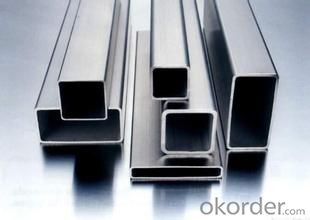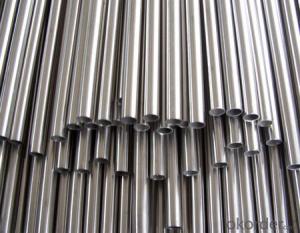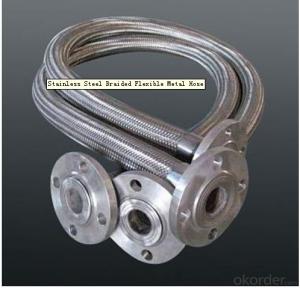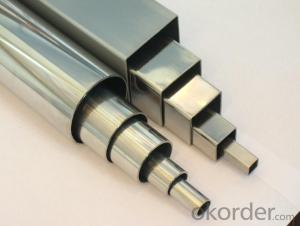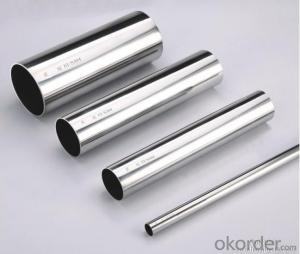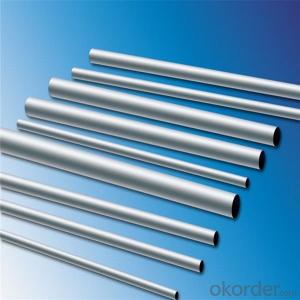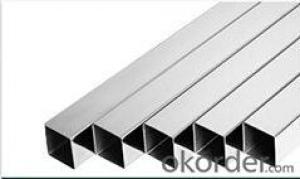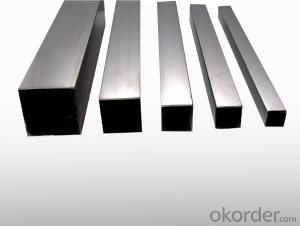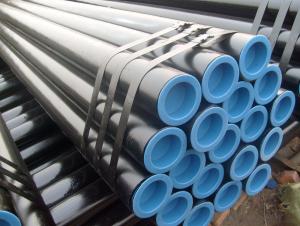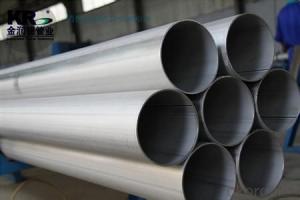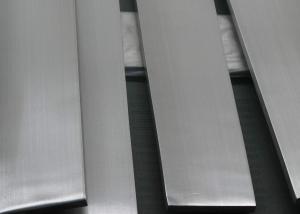Stainles stainless steel square tube
- Loading Port:
- Tianjin
- Payment Terms:
- TT OR LC
- Min Order Qty:
- 5 m.t.
- Supply Capability:
- 4000 m.t./month
OKorder Service Pledge
Quality Product, Order Online Tracking, Timely Delivery
OKorder Financial Service
Credit Rating, Credit Services, Credit Purchasing
You Might Also Like
| Size | (12-219) x (1-5) x (4000 - 13000)mm | |
| Material grade | 304, 304L, TP304, TP304L, 316L, TP316L, 321, F321, etc. | |
| Standard | ISO 9001/ ASTM A269/ A270/ A312/ A213, GB 14976/ GB 13296 | |
| Description | Process Method | Cold drawn and than cold rolled |
| Surface Finish | 2B,BA, Annealing and Pickling,Matt Finish or Satin Finish, Mirror Finish, Wire Drawing or Hairline Finish | |
| Ends Finish | Plain ends or Bevelled ends | |
| Test | Eddy current/ Hydrostatic/ Ultrasonic/ Intergranular Corrosion or according to customers' request | |
| Application | For use in the Petroleum, Smelting, Foodstuff, Power, Papermaking, Chemical, Medical Equipment, Aviation, Boiler Heat-Exchanger and other fields | |
| Packing | Each in PVC bags, bundles with knitted plastic bag, wooden cases or according to customers' request | |
- Q: Are stainless steel pipes suitable for hygienic applications?
- Yes, stainless steel pipes are highly suitable for hygienic applications due to their non-porous surface, corrosion resistance, and ability to withstand high temperatures and pressures. They are widely used in industries such as food processing, pharmaceuticals, and water treatment where cleanliness and sanitation are crucial.
- Q: What is the maximum pressure that stainless steel pipes can handle?
- The maximum pressure that stainless steel pipes can handle depends on various factors such as the grade of stainless steel, pipe thickness, and diameter. Generally, stainless steel pipes are capable of handling high pressures ranging from a few hundred to several thousand pounds per square inch (psi). It is crucial to consult industry standards, specifications, and engineering guidelines to determine the exact maximum pressure capacity for a specific stainless steel pipe.
- Q: How do you calculate the flow rate of fluid through stainless steel pipes?
- To calculate the flow rate of fluid through stainless steel pipes, you can use the Bernoulli's equation or the Darcy-Weisbach equation. Both equations take into account various factors such as the diameter of the pipe, the length of the pipe, the viscosity of the fluid, and the pressure difference between the two ends of the pipe. 1. Bernoulli's equation: This equation is based on the principle of conservation of energy and relates the pressure, velocity, and elevation of a fluid along a streamline. The equation is as follows: P1 + 0.5 * ρ * V1^2 + ρ * g * h1 = P2 + 0.5 * ρ * V2^2 + ρ * g * h2 Where: - P1 and P2 are the pressures at the two ends of the pipe. - ρ is the density of the fluid. - V1 and V2 are the velocities of the fluid at the two ends of the pipe. - g is the acceleration due to gravity. - h1 and h2 are the elevations of the fluid at the two ends of the pipe. By rearranging the equation and solving for V1 or V2, you can calculate the velocity of the fluid. Multiplying the velocity by the cross-sectional area of the pipe will give you the flow rate. 2. Darcy-Weisbach equation: This equation is commonly used for calculating the pressure drop or head loss in a pipe due to the frictional resistance of the fluid flow. The equation is as follows: ΔP = f * (L / D) * (ρ * V^2 / 2) Where: - ΔP is the pressure drop between the two ends of the pipe. - f is the Darcy friction factor, which depends on the Reynolds number and the roughness of the pipe. - L is the length of the pipe. - D is the diameter of the pipe. - ρ is the density of the fluid. - V is the velocity of the fluid. By rearranging the equation and solving for V, you can calculate the velocity of the fluid. Multiplying the velocity by the cross-sectional area of the pipe will give you the flow rate. It is important to note that these equations provide theoretical calculations, and actual flow rates may vary due to other factors such as pipe roughness, fittings, and bends. Therefore, it is recommended to consider these factors and conduct experiments or consult industry standards for more accurate calculations.
- Q: What are the temperature limits for stainless steel pipes?
- The temperature limits for stainless steel pipes can vary depending on the grade of stainless steel used. Generally, stainless steel pipes can withstand temperatures ranging from -150°C to 1100°C (-238°F to 2012°F). However, it is crucial to consider factors such as the specific stainless steel grade, the application, and any potential thermal expansion or contraction issues when determining the temperature limits for a particular stainless steel pipe.
- Q: Why can't stainless steel tubes be cut with acetylene?
- To know why stainless steel tubes cannot be cut by acetylene, we must first understand why carbon steel can be cut by oxygen acetylene flame
- Q: Can stainless steel pipes be bent?
- Indeed, it is possible to bend stainless steel pipes. Stainless steel, being an incredibly versatile material, possesses remarkable strength and ductility, enabling it to undergo bending without any risk of breakage or cracking. To achieve the desired outcome, the bending process employs a variety of techniques, including cold bending, induction bending, or hot bending, depending on the pipe's thickness and the desired outcome. With the ability to be bent to different angles and shapes, stainless steel pipes find themselves well-suited for a broad range of applications in construction, plumbing, and the automotive industry. Nonetheless, it is vital to emphasize that professionals or specialized equipment must be employed to carry out the bending process, ensuring the stainless steel pipes' structural integrity and overall quality.
- Q: What is the difference between 321 and 316 stainless steel pipes?
- The main difference between 321 and 316 stainless steel pipes lies in their chemical composition and intended applications. 321 stainless steel pipes contain titanium, which stabilizes the material against chromium carbide formation. This makes it highly resistant to intergranular corrosion, even at elevated temperatures. As a result, 321 stainless steel pipes are commonly used in applications where high temperatures are involved, such as in the aerospace and power generation industries. On the other hand, 316 stainless steel pipes do not contain titanium but have molybdenum in their composition. This addition enhances the material's corrosion resistance, particularly in environments with chloride ions, making it suitable for applications in marine and coastal environments. Additionally, 316 stainless steel pipes are often used in the food and beverage industry due to their excellent resistance to acids and chemicals. In summary, while both 321 and 316 stainless steel pipes offer excellent corrosion resistance, the presence of titanium in 321 stainless steel pipes provides enhanced resistance to intergranular corrosion at high temperatures, whereas the addition of molybdenum in 316 stainless steel pipes improves their resistance to chloride-based corrosion in marine and coastal environments.
- Q: What is the difference between seamless and double submerged arc welded stainless steel pipes?
- The main difference between seamless and double submerged arc welded stainless steel pipes lies in their production process. Seamless pipes are manufactured without any welding or seams, resulting in a smooth and continuous pipe with uniform strength throughout. On the other hand, double submerged arc welded pipes are created by welding two separate pieces of steel together using the submerged arc welding method. This creates a welded joint along the length of the pipe. While both types of pipes have their own advantages and applications, seamless pipes are generally preferred for their superior strength, durability, and resistance to corrosion.
- Q: What are the limitations of using stainless steel pipes?
- Some limitations of using stainless steel pipes include their higher cost compared to other materials, their susceptibility to corrosion in certain environments, and their lower thermal conductivity compared to materials like copper. Additionally, stainless steel pipes may be more difficult to cut and weld, and their strength and durability may vary depending on the specific grade of stainless steel used.
- Q: What is the external coating used for stainless steel pipes?
- Depending on the specific application and requirements, the external coating utilized on stainless steel pipes may differ. Nevertheless, a frequently employed external coating for these pipes consists of either epoxy or polyethylene. This particular coating offers protection against corrosion, abrasion, and various environmental elements. It aids in prolonging the pipes' lifespan and guaranteeing their durability in diverse industries such as oil and gas, chemical processing, and water distribution. Moreover, this coating can also serve aesthetic purposes by providing a sleek and visually pleasing surface finish.
Send your message to us
Stainles stainless steel square tube
- Loading Port:
- Tianjin
- Payment Terms:
- TT OR LC
- Min Order Qty:
- 5 m.t.
- Supply Capability:
- 4000 m.t./month
OKorder Service Pledge
Quality Product, Order Online Tracking, Timely Delivery
OKorder Financial Service
Credit Rating, Credit Services, Credit Purchasing
Similar products
Hot products
Hot Searches
Related keywords

